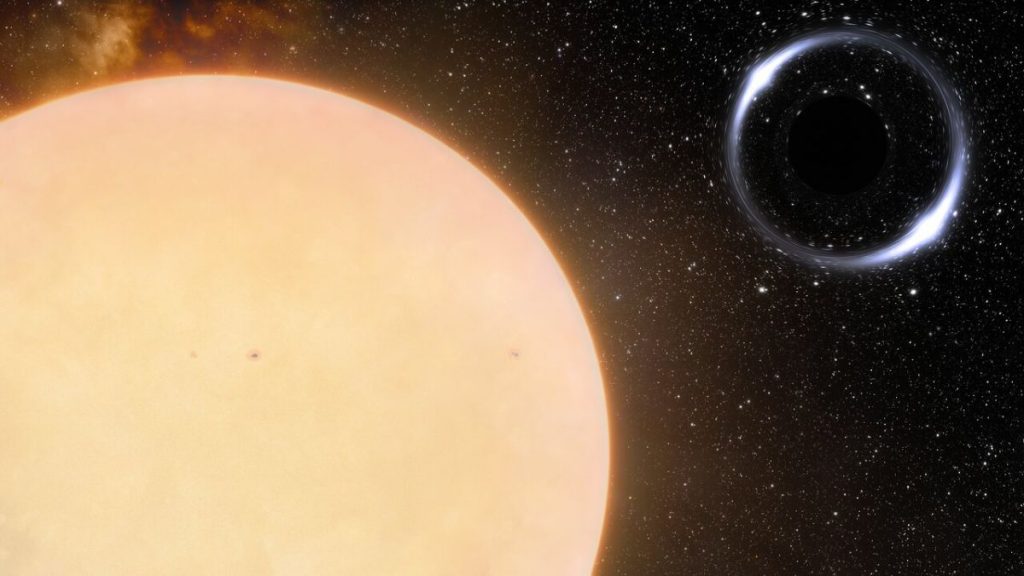The black hole record books have just been rewritten.
A black hole about 10 times more massive than our sun lurks just 1,560 light-years from Earth, a new study reports. That’s about twice as close as the previous proximity champ.
The newfound object, a stellar-mass black hole called Gaia BH1, resides in a binary system whose other member is a sunlike star. That star is about as far from its companion black hole as Earth is from the sun, which makes Gaia BH1 very special indeed.
“While there have been many claimed detections of systems like this, almost all these discoveries have subsequently been refuted,” study lead author Kareem El-Badry, of the Harvard-Smithsonian Center for Astrophysics in Massachusetts and the Max Planck Institute for Astronomy in Germany, said in a statement (opens in new tab). “This is the first unambiguous detection of a sunlike star in a wide orbit around a stellar-mass black hole in our galaxy.”
Related: Black holes of the universe (images)
Astronomers think that our Milky Way galaxy harbors about 100 million stellar-mass black holes, light-gobbling objects that are five to 100 times more massive than the sun.
Their small size makes these bodies relatively hard to detect, however, especially by telescope. (Gravitational-wave detectors have had more success recently, finding evidence of mergers involving these objects.) And the ones that scientists do see tend to be “X-ray binaries,” black holes that pull material from a companion star into an accretion disk around themselves. This fast-orbiting dust and gas emits X-rays, high-energy light that some powerful telescopes can observe.
Not all stellar-mass black holes that inhabit binary systems are actively feeding, however. Finding these dormant objects is even more difficult and requires different strategies.
The researchers employed one such alternate technique in the new study. They pored over data gathered by the European Space Agency’s (ESA) Gaia spacecraft, which is precisely mapping the positions, speeds and trajectories of about 2 billion Milky Way stars.
One of those stars is the companion to Gaia BH1. Its motion displays tiny irregularities — an indication that something massive and unseen is tugging on it gravitationally.
The Gaia measurements suggested that a black hole could be that tugger, but the scientists needed more data to know for sure. So they studied the star with a number of ground-based instruments, including the Gemini North and Keck 1 telescopes in Hawaii and the Magellan Clay and MPG/ESO telescopes in Chile.
These follow-up observations, combined with the Gaia data, allowed the team to take the system’s measure in detail. The unseen object contains the mass of 10 suns, they determined, and orbits the system’s center of mass about once every 186 Earth days. And it must be a black hole.
“Our Gemini follow-up observations confirmed beyond reasonable doubt that the binary contains a normal star and at least one dormant black hole,” El-Badry said. “We could find no plausible astrophysical scenario that can explain the observed orbit of the system that doesn’t involve at least one black hole.”
If the unseen object in Gaia BH1 were a star, for example, it would be far brighter than its companion, and therefore easier to see. But none of the team’s observations revealed a hint of a second star in the system.
The Gaia BH1 system is intriguing, and not just because it’s relatively close to us. (Close in the cosmic scheme of things, anyway; the Milky Way’s famous spiral disc is about 100,000 light-years wide.) The study team isn’t sure how the star and black hole came to be in their current positions.
Gaia BH1’s mass indicates that the star that died and gave rise to it must have been huge — at least 20 solar masses or so. Such giants live for just a few million years, and they puff up tremendously before they give up the ghost.
Modeling work suggests that such puffing would likely have destroyed the companion before it had a chance to evolve into a sunlike star (if the two were born at the same time). Or, if it survived, it should have ended up on a much tighter orbit than the one it currently occupies, the researchers said.
“It is interesting that this system is not easily accommodated by standard binary evolution models,” El-Badry said. “It poses many questions about how this binary system was formed, as well as how many of these dormant black holes there are out there.”
The new study (opens in new tab) was published online today (Nov. 4) in the journal Monthly Notices of the Royal Astronomical Society.
Mike Wall is the author of “Out There (opens in new tab)” (Grand Central Publishing, 2018; illustrated by Karl Tate), a book about the search for alien life. Follow him on Twitter @michaeldwall (opens in new tab). Follow us on Twitter @Spacedotcom (opens in new tab) or on Facebook (opens in new tab).

